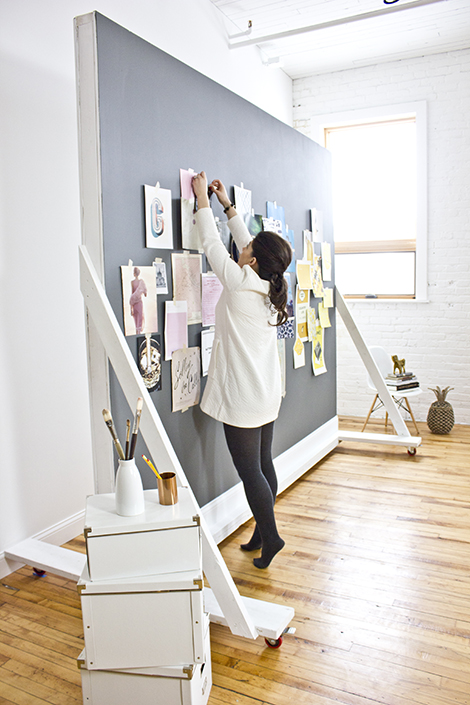
I’m thrilled to introduce a guest contributor for today, Megan Gonzalez. Perhaps you’ve seen her work with her company, MaeMae. I’ve been a fan of her beautiful work for quite awhile now and I’ve long been impressed with the style boards she creates and features on her site for each client (and the movie she created?! It’s a must watch!). They are in itself beautiful works of art. As I’ve been featuring more and more style boards here for different projects (remember Becca’s wedding inspiration board?), I thought it would be wonderful to hear from the expert on how to create them for your own projects.
Hi! I’m Megan and I run MaeMae, a creative studio located in Minneapolis, MN. Since I was in elementary school, I have collected magazines tears, notes and drawings from friends, and postage stamps. When I got my first computer in college I filled folders on my desktop with photos and designs I found online as well as scans and photos of pages from books I discovered at the campus’ library. Now if I didn’t have the job I do, I think we’d label this all compulsive hoarding… but fortunately I get to put all of these found and collected objects and images to good use in my work!At MaeMae I work as a Creative Director helping companies create cohesive and compelling visual messaging. This can mean a variety of things depending on the project or company. I design: logos, websites, and print materials; direct: marketing campaigns, photoshoots, and films; and I develop: patterns for clothing, concepts for books, and strategies for reaching people.




 WHERE TO START
WHERE TO START
To do any of these things, I need to start with a clear visual direction. I use mood boards (or you can call them style boards or inspiration boards) to begin creating this direction. I find both the process of creating these boards and the end result essential to doing my job right. I began making mood boards in 2009 to do just this, and they have evolved along the way. I now use them not just as direction for a project but also for:
- organizing ideas for a photoshoot regarding lighting, propping, and layout
- decorating my workspaces
- the actual final product (recently made a book cover out of a mood board!)
- doodling!
Where to find inspiration
I am often asked where I find inspiration. To me, “where” is less important than “when.” I make it a point to follow my gut whenever I see something that inspires me, and save it away on my computer or on a shelf. Saving imagery or objects that speak to me (and are possibly unrelated to a particular project) gives me a rich, personal library of inspiration that I can turn to when I am starting a project. I find the order of collecting before I know what I may use the inspiration for to be a powerful way to confirm that my inspiration or direction is true to my personal visual language and style. Once I’ve started a project, I do not like to look for inspiration within the same industry or world that my client lives within because then I may create a direction that is too similar to everyone else’s.
But since you’ll ask ;-), here’s where I find my inspiration:
- vintage books
- magazines (currently loving food and interior)
- films & tv shows (loving Chef’s Table on Netflix)
- found objects (my go to place is Hunt & Gather here in Mpls)
- the garbage (or the sidewalk!)
- a garden (or your backyard! I especially love dead, dried things)
- photos I take on my phone (usually of type, colors, textures)
- Pinterest.com*
- Designspiration.net
*A thought on Pinterest:
In the same way you would do anything else creative in your life, make sure that your Pinterest feed is true to you. Pinterest gives you the ability to save a plethora of boards (I have way too many… 102…see them here) where you can save unrelated things all on the same account. I find this can be dangerous now that Pinterest suggests pins for you based on what you have already pinned. “Dangerous?!” you might say? “Is that a little dramatic?” NO! The danger to me is that your feed can fill up with, say tips and tricks on how to get your grout clean, or other visually uninspiring photos that can deflate that natural process of saving inspirations visuals. Maybe if you really need to know how to keep your grout white you could get a second account to keep one pretty and one practical. I also make it a point to click the “I’m not into this pin” button on suggest images I don’t like to make sure my feed stays INSPIRING to ME.
Create a digital board
For most projects I start with a digital version of an inspiration boards that I create in InDesign, but often (especially for photoshoots) the inspiration board manifests itself physically as well or has a secondary physical version.
The boards need to be balanced and cohesive. Those seem like opposite statements, but being able to do those two things is what makes the board sing!
 Here’s what to include in a mood board:
Here’s what to include in a mood board:
- strong color palette
- different mediums (type, paint, photo, objects)
- different scale and perspective of items (zoomed in moments, further away moments)
- different textures (smooth, fuzzy, patinated, shiny)
I print off my pictures online on glossy photo paper so that they’re ready to hang.

You can see more of my mood boards on my Instagram account under #maespiration! Happy boarding!
This post is by Megan Gonzalez of MaeMae & Co | Please see her site for photography credits








 WHERE TO START
WHERE TO START





 Here’s what to include in a mood board:
Here’s what to include in a mood board:


Comments